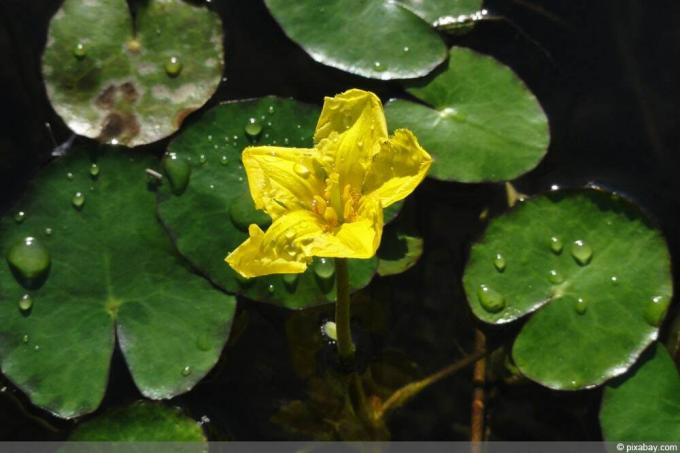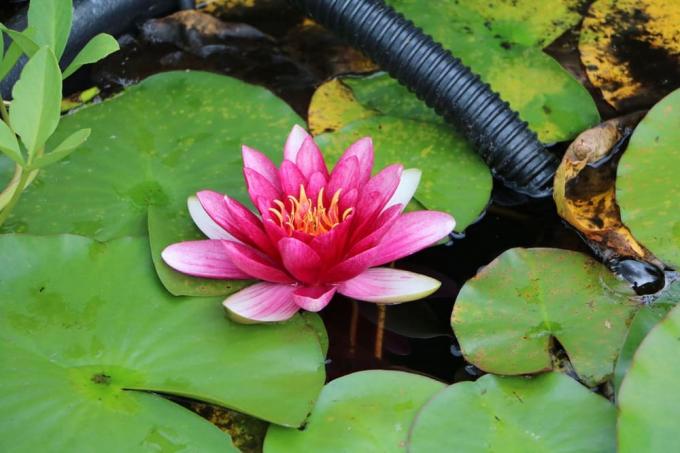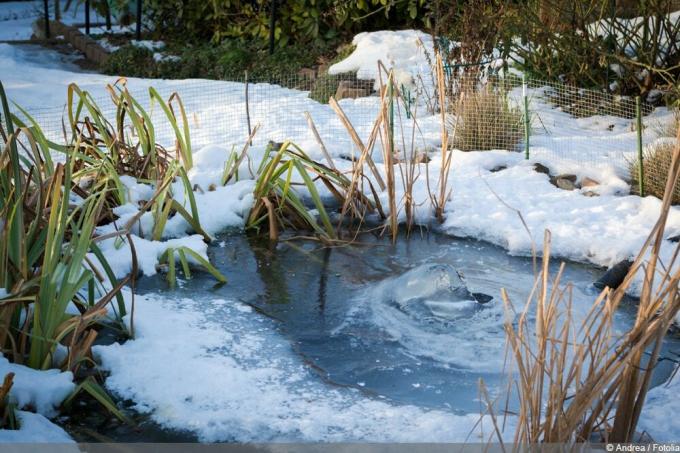

Table of contents
- useful information
- location and pond size
- water quality
- soil condition
- Plant
- Fertilize
- Cut
- hibernate
- multiply
- sowing
- division
- diseases and pests
With unorthodox growth, the sea jug causes headaches for home gardeners when planting in the garden pond. Leaves and flowers are enthroned above ground on flowing, meter-long stems. Below the surface of the water, the floating leaf plant is partly rooted in the bottom of the pond. These instructions explain in a practical way how to plant the native aquatic plant correctly. A detailed guide illuminates the exemplary care from A-Z.
useful information
With its glossy green, round leaves and bright yellow flowers, the sea jug is reminiscent of a water lily. In fact, the native aquatic plant is one of the fever clover plants with robust winter hardiness. Standing and moderately flowing bodies of water with clean water are their territory. Where sea candies feel in good hands, they conquer their territory above and below the water. Up to 150 centimeters long, flowing stems carry numerous lush green floating leaves. Yellow flowers appear in summer from June to September. The leaf stalks usually reach to the bottom of the pond to take root there. Countless hydropots sit on the underside of the leaves, which make themselves useful as busy "water drinkers". The tiny glands continuously filter excess nutrients from the water and deprive annoying algae of their livelihood.
In the wild, the sea jug has become rare. Larger deposits can still be found along the Danube and in the Upper Rhine Plain. In the rest of Central Europe, the floating leaf plants have become so rare that they are protected. One more reason for the environmentally conscious house gardener to plant at least one sea jug in his private water world and in this way to contribute to the preservation of the charismatic pond plant.
location and pond size
In a sunny to semi-shady location, sea jugs are at their best. Under the shady conditions of a cool pond, you will look in vain for the distinctive starry blossoms and shapely leaves. The plants cannot fulfill their useful function as a natural algae killer in locations with poor light either. Since the magnificent water beauties tend to form expansive foothills, the water surface should go well beyond a mini-pond. A medium-sized pond between 5 and 15 square meters and 60 to 80 centimeters deep offers sea cans sufficient capacity for magnificent growth with a lush flowering period.
Tip:
Sea jugs are excellent problem solvers for naturally shading a pond in full sun. The floating sunbathers love to catch the sunlight with their decorative leaves. Less sun-loving plants and animals in the garden water benefit from this.
water quality

Before you plant young sea urchins, please put the water quality to the test. The rarity worth protecting is not least due to an unsuitable degree of hardness and too high a pH value in our waters. This is how the ideal pond water should be:
- Slightly acidic to neutral pH between 6 and 7
- Soft water with a degree of hardness below 10° dH
Water tests that are easy to use are available at garden centers and pond supply stores. Please carry out the inexpensive and uncomplicated test even if the water is clear and clean. Both of these criteria are essential for vital growth and cannot be seen with the naked eye.
soil condition
Only in combination with the right soil conditions will your water world get the approval of a sea jug. A peat to peat pond bottom offers the rhizomes the ideal framework if it is rich in nutrients and structured humus at the same time.
Plant
The best time to plant sea jugs is in spring, when the pond water and shallow water zone have completely thawed. Pre-grown young plants are usually in the seed pot, which is not suitable for expert planting. For this purpose, special plant baskets are available for the perfect planting of pond plants. Furthermore, the practical baskets score with the advantage that they keep the growth of space-consuming sea-pot runners in check. Although the native aquatic plants are used in the shallow water zone, they later migrate unerringly to regions with a water depth of 80 to 100 centimeters. Repotting and planting go hand in hand when sea jugs move into the garden pond. Here's how to do it step-by-step:
- Fill the plant basket with aquatic plant substrate or bog soil
- Repot the young plant and plant in the middle while maintaining the previous planting depth
- Spread lime-free gravel on the substrate to protect against leaching
Position the plant basket on the bottom of the shallow water zone. In this area the water is between 20 and 40 centimeters deep. Do not anchor the basket. After a transition phase of acclimatization, the self-confident floating leaf plant will look for its favorite place on its own. If this process is not in your interest, fix the plant basket immediately in the appropriate water zone from a depth of 60 centimeters.
Tip:
Socialize sea jugs with aquatic plants that have similar requirements. Together with cattails (Typha), marsh iris (Iris pseudacorus) and pikeweed (Pontederia cordata), you can create a varied and natural appearance for your water world.
Fertilize
Fertilizing is rarely part of the care program for sea candies. The picturesque pond plant draws its nutrients from two natural sources. With long, slender rhizomes, it roots through the nutritious substrate, where dead plant parts, microorganisms and fish excrement are continuously transformed into valuable humus. The undersides of the leaves, which are equipped with hydropots, extract plenty of nutrients from the water in order to create energy reserves inside the plant. Well-balanced pond water thus eliminates the need for an additional supply of nutrients, as is customary for conventional garden perennials.
Yellowed leaves, stunted growth and sparse flowers, on the other hand, signal deficiency symptoms. In this exceptional case, the suffering sea jug benefits from a special liquid fertilizer for aquatic plants. Only apply the fertilizer for a limited time so as not to trigger an unwanted algal bloom. If the deficiency symptoms subside, discontinue the supplementary nutrient supply promptly.
Cut
Planting in the escape-proof plant basket alone is not always enough to curb the growth of sea jugs. If the runners spread uncontrollably on the water surface, make a note of a cut back on the care plan. The good-natured cut compatibility allows any desired cut size. For disinfection, powder larger cuts with charcoal powder or bedrock powder. By regularly removing dead leaves and withered flowers, the floating beauty always shines with a well-groomed appearance.
hibernate

Before the onset of winter, sea jugs shed their leaves and retreat to the bottom of the pond. Thanks to hardy rhizomes, the native aquatic plants survive the cold season unscathed. Only in spring do the long, thin leaf stalks sprout from the rootstock. Floating leaves sprout just before the start of the flowering period in June. This process does not rely on any special overwintering precautions. So that the dead leaf mass does not affect the natural balance in the water, scoop off dead leaves regularly.
multiply
Sea urchins can be propagated equally well using generative and vegetative methods. Just one specimen in the water is enough to breed a whole flock of magnificent offspring. Both procedures are explained in more detail below.
sowing
If you are aiming for a larger number of new sea cans, it is advisable to sow seeds. In this case, there is no need for much guesswork about the final result, since it is a pure species and not a combination of different parent plants. In the fall, a Nymphoides peltata releases numerous ciliated seeds that have ripened underwater in fruit capsules. Each seed is equipped with small air chambers so that it can float on the water surface. You can either collect the seeds or buy them from specialist retailers. How to sow:
- Fill the watertight seed tray with peat soil or low-lime potting soil
- Press the seeds 1 to 2 cm deep into the substrate at short intervals and sieve over with potting soil
- Press the substrate lightly with a flat board
- Fill in lime-free water up to 1 cm above the soil surface
- Set up in a partially shaded location at 18 to 22 degrees Celsius
- Check the water level in the bowl regularly and top up if necessary
Germination will begin within two to four weeks, recognizable as green leaf tips breaking through the soil. When your little ones grow above the surface of the water, it's time to separate them into a pot of aquatic plant soil. Place the pots in a bowl filled with soft water until springtime when planting begins.
If seeds refuse to germinate, a cold stimulus stimulates growth. To do this, place the seeds on the winter balcony for four to six weeks, protected by a transparent hood. In regions with severe winters, subject the seeds to the required cold stimulus in the vegetable compartment of the refrigerator. At 0 to 4 degrees Celsius, the cotyledons are not long in coming.
division
The propagation of sea jugs succeeds more uncomplicated over the way of the division. The best time is in spring, after the end of the main frost period. Get the mother plant and plant basket out of the water. Then pick up the rhizome to remove soil, stones and dead roots. Divide the cleaned rootstock into several segments with a length of 10 to 20 centimeters with a spade, knife or scissors. Now you can plant each section in a separate plant basket and put it in the water at the desired location.
diseases and pests

As a rule, you will not have to complain about illnesses on a sea jug. Among the pests, water lily aphids (Rhopalosiphum nymphaea) brazenly target other floating leaf plants and don't spare sea jugs either. The infestation can be recognized by light spots on the leaves and curled leaf edges as a result of suction damage. Of course, the lice themselves are more noticeable than the symptoms. The 1-2 mm small, black to dark green insects colonize leaves and stems in droves. Fatally, aphids excrete honeydew, which serves as a target for sooty mold and clogs the leaf pores. Control with chemical insecticides is prohibited due to the endangerment of the fish and microorganisms in the pond. However, you are not completely defenseless against the lice invasion.
How to act correctly:
- Rinse off affected parts of the plant with a strong jet of water
- Treat the top and bottom of the leaves
- Wipe the lice off accessible leaves
- Repeat control measures daily for a period of one week
Seekannen gardeners report good results with the use of horsetail broth. You can purchase the purely natural product as a ready-made solution from specialist retailers or make it yourself. Apply the spray mixture every 5 to 10 days until there are no more aphids to be seen.
 garden editorial
garden editorial I write about everything that interests me in my garden.
Learn more about floating plants - care

Duckweed in the pond | What to do with duckweed?
Duckweed sometimes settles in the pond all by itself and then likes to get the upper hand. This text explains why this is so and how it can be removed.

Shell flower, water lettuce: care from A-Z
The mussel flower (Pistia stratiotes) is also known under the name water lettuce. It can be cultivated in ponds and aquariums and is extremely decorative. But what do you have to pay attention to when it comes to care? Our guide shows it.

Dwarf water lily - care, planting & wintering
A garden pond is only complete and a feast for the eyes with water lilies. For certain ponds, the dwarf water lily offers the only solution for flowery pond design. The plant expert explains the most important details in terms of plants, care and wintering.

Plant water lilies: repot and plant in 8 steps
Water lilies are an enrichment for every garden, the lovely plants delight the eye with their graceful blooms. When planting and repotting water lilies, however, there are a few important things to consider so that the water flowers can feel comfortable and unfold their full beauty.

Overwintering water lilies - caring for pond plants in winter
What would a garden pond be without decorative aquatic plants in it? Especially since pond and marsh plants not only have a decorative effect, but also keep the pond clean and ensure the necessary oxygen supply. However, not all species are hardy and therefore require special attention in the cold season.

Hornblatt (hornwort) - care and propagation
The horn leaf, which is also popularly known as hornwort, is one of the plants that can often be found in aquariums or garden ponds. The easy-care aquatic plant with its long, leafy tendrils is not only a beautiful sight, it also serves as an indicator of the quality of the water.



